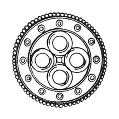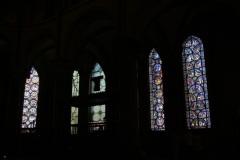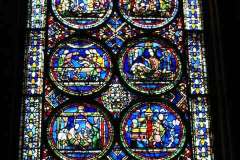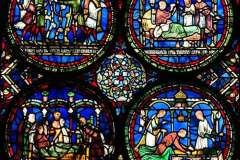There were originally 12 Miracle windows, six on the north side and six on the south side of the shrine of St Thomas in the centre of the Trinity chapel. All the windows were complete by the time the Translation of St Thomas’ remains from the crypt to the Trinity chapel on 7th July 1220 (Image 1)
As in the north windows, there are scenes portraying miracles that were seen to have occurred as a result of prayer to, or the intervention of, St Thomas.
From the east, the glass in the first window is original, with late 19th century replacement panels at the top of the window and an early 20th century replacement panel at the bottom left (Image 2). The next window is clear glass as the original glass is lost. At the bottom of the next window, the third, the glazier Caldwell Jr inserted two of his own creations. The famous image of pilgrims travelling to Canterbury is in fact a 20th century Caldwell forgery. The fifth and sixth windows contain original medieval glass and late 19th and early 20th century replacement panels.
There are many scenes portrayed in these three windows. The stories they depict were drawn from Benedict of Peterborough’s Passion and Miracles of St Thomas Becket and, for the first window, William of Canterbury’s Miracles of St Thomas Becket. It is therefore possible to identify the names and ailments of the people portrayed in the windows. Latin inscriptions explain the stories.
What to see (selecting one story, this one from William of Canterbury’s Miracles):
In the first window, the story of Adam the forester is told in two roundels, (Image 3). In the first roundel are two foresters Adam, on the left, is shot in the neck by an arrow that has been fired by a poacher in green centre right holding the bow. The second forester, second left, has an axe in his belt. Another poacher on the right is walking away with a deer slung over his shoulder. The inscription, FVR FVGIENS GVTTVR P(er)FORAT IN SEQVENTIS, translates as “The thief flees as he pierces through the throat of his pursuer”.
In the next panel to the right, Adam is sitting up in bed drinking the ‘Canterbury water,’ which contained blood of the martyr. This was dispensed to pilgrims to effect cures. The inscription, BIBENS AQVAM S. TH. SANVS EFFEC…VA, translates as “Drinking the water of St Thomas, he is made well by the water.”
The scene at the bottom left of the window is a Caldwell Jr creation; the scene at the bottom left appears to belong to a different story, not Adam the Forester’s.
Sources: see standard cathedral sources
AT/RK
Updated June 2025 with thanks to Rachel Koopmans for ensuring an accurate description of the dates of the glass and the interpretation of the artwork.



